Author Archives: Michelle Rowe-Jardine
-
-
What happens to food after it’s donated?
Comments Off on What happens to food after it’s donated?The journey of a food donation
Have you ever wondered what happens after you drop off food at North York Harvest Food Bank?
Lettuce give you an example…
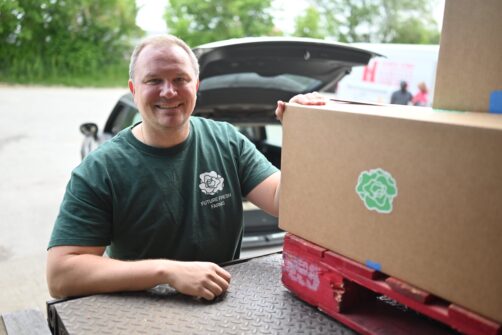
Our community partner Future Fresh Farms arrives at the warehouse on a Friday morning with a generous donation of their fresh, locally grown lettuce! They turn unusable, grey commercial space in Toronto into urban vertical farms to produce aeroponically grown food.
Over the past three months they have contributed 1,062 lbs of fresh produce to fight food insecurity and support our community!
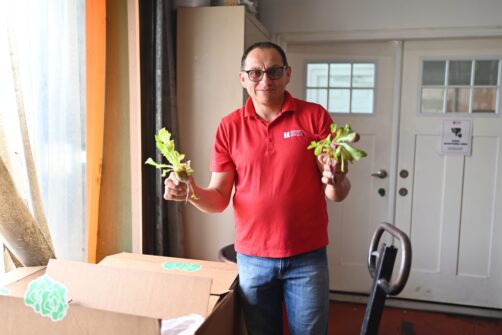
Once food arrives, our Operations team receives the items, weighs, and tracks them so we know how much food we have on hand to distribute, how long we’ve had it, and when/where it will be delivered to support individuals and families in need.
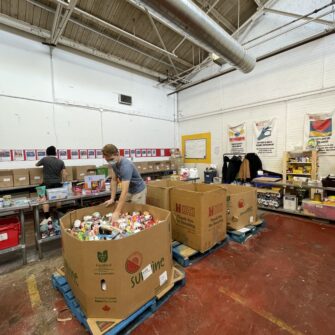
For non-perishable items dropped off from food drives or partner organizations, they’re added into the donation bins in our sort room to be inspected for safety by our diligent volunteers, and then sorted into boxes by category.
North York Harvest supports 30,000 clients in meeting their food needs every month, so food has to move in and out of the warehouse quickly and efficiently – especially perishable items like lettuce!
Each week we distribute about 46,000 lbs of food across our four community food spaces and our network of 37 partner agencies.
En Route
The lettuce is loaded up first thing in the morning into one of our delivery trucks.
First stop: Our Lawrence Heights Community Food Space.
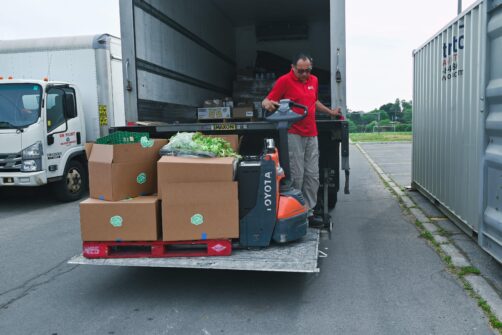
The Community Food Space is located within the Lawrence Heights Community Centre in the dance studio.
Our driver Oscar arrives at Lawrence Heights ahead of their program day at 11am. Volunteers help unload skids of food to put on the shelves and into the fridge as they set up for a busy day providing nourishing food to our community.
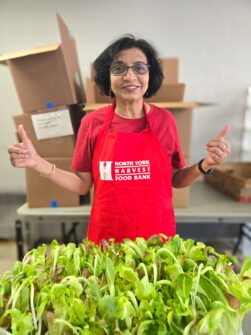
Tables, chairs, and shelving are pulled out of storage and loaded with non-perishable items from the morning’s delivery. In addition to non-perishables, clients will also have access to milk, eggs, bread, cucumbers, and of course, lettuce.
Lawrence Heights serves a diverse community, supporting 1340 clients every month in meeting their food needs.
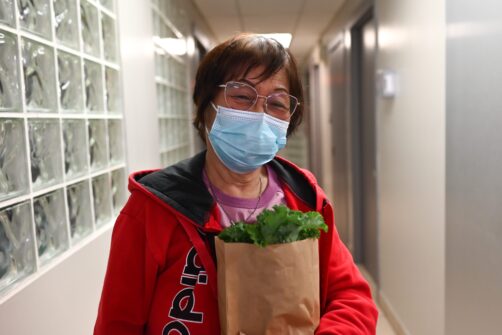
One of our community members, Flor, says, “I was so happy to see lettuce available!”
“It’s hard for seniors to find work. I’m having surgery soon, and I need the nutrients to be healthy, but when I go to the grocery store everything is so expensive,” Flor says.
“Whenever I get fruits and vegetables from the food bank, I like to make them into healthy juices,” she adds.
Every day our community comes together to ensure neighbours facing food insecurity have enough to eat. Every donation: From bottles of cooking oil, to pasta, and fresh produce makes this critical journey from our warehouse to our food spaces and into the hands of someone who needs it.
Learn how you can donate food and funds to support our neighbours in need.
-
Photovoice Project: Meet Hanna
Comments Off on Photovoice Project: Meet HannaOur Photovoice project draws from a participatory research method that uses photography and stories. Our aim is to provide a platform for our community to voice their lived experiences around food access. Hanna is a North York Harvest Food Bank client who agreed to share her story.
By Hanna Subbota,
Submitted April, 2024I am Hanna Subbota, and my daughter is Diana. We are Ukrainians, from a city in the Dnepropetrovsk region. I graduated from Zaporizhzhya
 University, where I studied medicine and worked as a nurse for five years before I became a chemistry and biology teacher for 18 years – and then I had to leave Ukraine.
University, where I studied medicine and worked as a nurse for five years before I became a chemistry and biology teacher for 18 years – and then I had to leave Ukraine. It is so sad what is happening in my hometown. Our city continues to be shelled every day. It is not safe anywhere.
My 17-year-old daughter and I left the city of Nikopol on March 7, 2022, at the beginning of the war because in front of us is Energodar (by water, 8 kilometres away) and the Zaporozhye nuclear power plant, which was captured by our enemies on March 4, 2022.
They started to scare us that the nuclear power plant would be blown up. If this happens, it will be worse than Chernobyl. A lot of people will die from radiation within a radius of 100-1000 kilometres.
We went through a difficult evacuation: We lived for 7 days in Poland on cots, 2 days in Germany, and then arrived in France, where we received a visa to Canada. We lived in France for almost 2 years, but over the last 3 months they stopped paying us assistance.
We began to accumulate debts, plus we borrowed money for tickets to Toronto, since our program (Assistance to Ukrainians) ends on March 31, 2024.
We received $4,500 to help the Ukrainians, but we paid $2,800 for two months rent for one room. We paid off debts, gave away the money we took from other people for tickets to Toronto – so there is no money left. I don’t have anything.
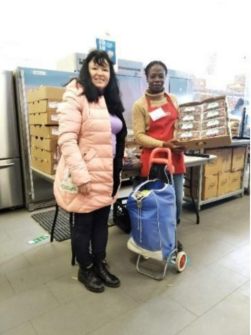 Right now, I have an urgent need to find housing. I am getting evicted in four weeks and it is very stressful – it is an emergency again for me and my family.
Right now, I have an urgent need to find housing. I am getting evicted in four weeks and it is very stressful – it is an emergency again for me and my family.I have not found a job yet. I do not speak English well. But North York Harvest Food Bank came to the rescue.
Now every Wednesday, once every two weeks, I go to the food bank for the necessary products: canned food, cereals, sweets, vegetables, fruits, herbs, and hygiene products.
We began to receive the necessary products from which we prepare food: our favorite borscht, mashed potatoes, porridge, salad. I am hoping to take courses to improve my English by so I can work in Canada. But first, I need to be financially stable and find housing.
We are very grateful for the help of North York Harvest Food Bank and all the people who help us.
Thank you very much!!!

-
Transforming food support into community power
Comments Off on Transforming food support into community powerTransforming Food Support Into Community Power
For 40 years, North York Harvest Food Bank has been a lifeline in the community— connecting people with dignified food assistance and critical resources they need to survive.
But now our lease is up and cannot be renewed; we have to move in 2026.
With 30,000 clients relying on us for emergency food support every month, we have to act quickly or risk disrupting essential operations.
That’s why we’re launching Crisis to Catalyst: A bold $6-million capital campaign to build a new 30,000+ sq. ft. Community Food Hub.
This urgent situation has brought our organization to a transformational turning point: We’re shifting from crisis response to long-term solutions that will empower our community for generations.Our new home will reimagine what a food bank can be – not just a safety net, but a launchpad for innovation. We will power local employment, support shelters, strengthen hundreds of partner agencies, and help thousands of families move from crisis to stability.
This Hub will:
- Strengthen warehousing and logistics for hundreds of community agencies
- Support student nutrition programs in schools, libraries, and beyond
- Triple our food storage capacity to meet rising demand
- Expand cold storage tenfold to deliver more fresh, nutritious food
- Scale up our Leadership in Logistics workforce development program
- Deliver food to shelters through our partnership with the City of Toronto
- Enable national food initiatives in partnership with Food Banks Canada
- Reduce the environmental impact of food waste
- Develop more innovative initiatives that deliver sustainable, long-term reductions in poverty
- Create shared space for community organizations to work, innovate, and grow — together
- Advance food security across Ontario by supplying affordable food to hundreds of nonprofit organizations through our social enterprise, FoodReach.
But we can’t do it without you.
The City of Toronto has recognized food insecurity as an emergency, with 1 in 10 residents now relying on food banks to survive.
This is our moment — and yours — to turn crisis into catalyst.
When you support this campaign, you’re investing in more than food; you’re investing in people, potential, and possibility. You’re sparking lasting change — felt in every meal served, every job created, every child nourished, and every barrier broken.
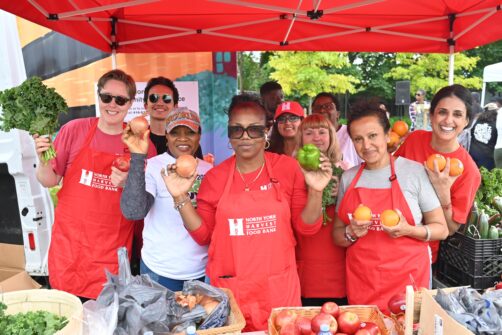
-
Legacy Giving: Donating to charity in Your Will
Comments Off on Legacy Giving: Donating to charity in Your WillDonating to charity in your Will

Leaving a Legacy of Hope: Shaping Our Community, Together
Imagine knowing that the values you hold dear can continue to make a difference in our community for years to come.
At North York Harvest Food Bank, we witness the power of community every day—neighbours helping neighbours, volunteers giving their time with compassion, and donors stepping forward to ensure families have access to nourishing food.
As Canadians, we understand the importance of looking out for one another. And when we think about the future of our community, ensuring that everyone can meet their basic needs—especially access to food—is a fundamental part of that vision.
That’s where the idea of legacy giving comes in.
You may have heard it called planned giving, or simply leaving a gift in your Will.
Why Legacy Giving Is Growing in Canada

A recent Will Power study showed that the number of Canadians planning charitable gifts in their Wills has increased from 5% to 8%. Why?
It’s a sign of growing awareness: more of us are realizing we can shape the future by supporting causes we believe in—without affecting what our families need today.
Inflation and cost of living may have put pressure on Canadian incomes. But the desire to help has never been stronger
A gift in your Will lets you create long-term impact without tapping into the money you need now. Even a small percentage—just 1%—can make a meaningful difference.
Explore how far your legacy can go with the Will Power calculator.
A story of care that lives on

Leaving a gift in your Will is a thoughtful, lasting way to extend your care beyond your lifetime.
Anne was one of North York Harvest’s most cherished and long-standing supporters. She believed deeply in the importance of nourishing children and providing opportunities for all families.
“When children are deprived of food, they are also deprived of a future,” she once shared.
For Anne, leaving a gift in her Will to North York Harvest was more than a financial decision—it was a reflection of her values. It was her way of continuing her care for the community she loved. Her legacy gift continues to support the children and families she cared about—quietly, meaningfully, and powerfully.
Imagine knowing that the values you hold dear can continue to make a difference in your community for years to come.
Why you might consider a Gift in Your Will to Charity

Many donors are surprised by just how far a small gift can go. Setting aside even 1% in your Will to a charity like North York Harvest can reduce taxes and still leave 99% to support your loved ones.
You can also leave a gift outside of your Will—by naming a charity as a beneficiary of your RRSP, life insurance policy, or other assets. And remember, your Will isn’t final. Most Canadians revise theirs more than once as life evolves.
Download our free Will planning guide for a step-by-step look at how to get started.
We always recommend speaking with a qualified financial advisor or lawyer to explore your options.
Learn more about how legacy gifts are changing lives

A gift in your Will isn’t about wealth—it’s about legacy. It’s about building a future where everyone can access food with dignity, and no one is left behind.
Whether your legacy looks like Anne’s or something uniquely your own, we would be honoured to be part of your story.
Want to Learn More? Let’s Start the Conversation
We’d be happy to speak with you—whether you’re just exploring the idea or ready to start the conversation. There’s no pressure, just support.
Natasha Bowes, CFRE, MFA-P
Director of Development and Marketing
Natasha@NorthYorkHarvest.com or 416.635.7771×2600Maria Soares
Philanthropy and Annual Giving Specialist
maria@northyorkharvest.com or 416.635.7771 x3300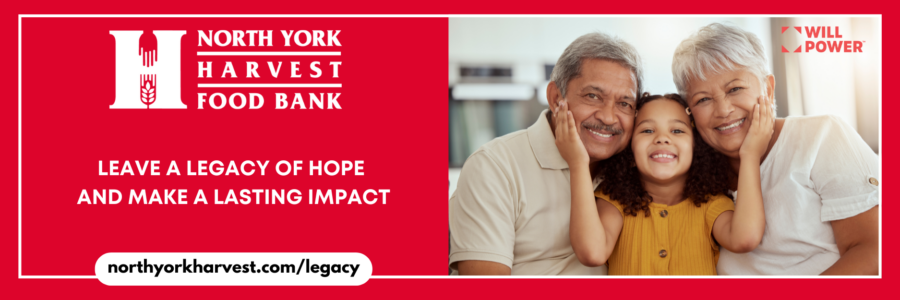
North York Harvest Food Bank is a proud partner in Will Power, a national campaign helping Canadians use their Wills to support causes they care about. Together, we’re building stronger, more resilient communities—today and for generations to come.
-
8 GREAT reasons to run a summer food drive!
Comments Off on 8 GREAT reasons to run a summer food drive!8 Great Reasons to Start a Summer Food Drive
Food drives are essential in helping 30,000 clients across our network meet their food needs every month. They’re especially important during the summer, when our shelves begin to empty but the need in our community remains just as high.
Here are 8 great reasons why YOU should start your very own food drive this summer!
1. Donations are much lower in the summertime
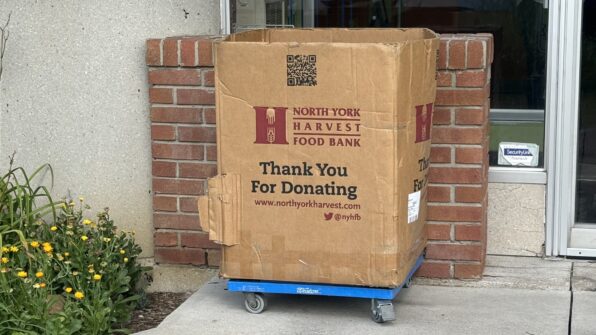
As the warm weather hits, people are focused on planning vacations and enjoying the great outdoors.At the food bank however, that means empty shelves. Summer hasn’t even started yet, but we’re already running critically low on many non-perishable essentials including pasta and canned fish.
Unfortunately, there is no vacation from hunger. Summer is a critical time for community support, and community food drives play an integral role in ensuring there’s enough food for our clients.
2. A child’s happy summer starts with good nutrition

Children need their energy for all the play and activities that come with summer. But without school snack programs, many families struggle to provide their children with enough nutritious food to fuel their day.
At North York Harvest, 1 in 4 people we support is a child. By hosting a food drive, you’ll be easing a family’s stress so they can have a great summer, too.
3. Connect with your community & each other
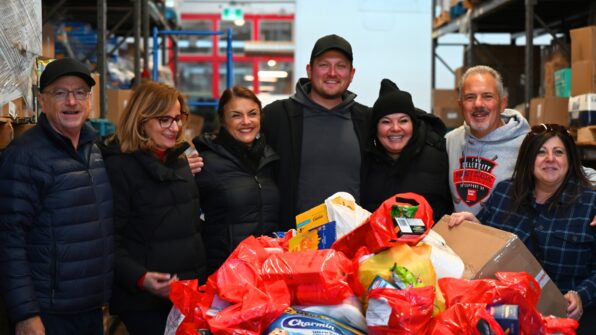
A food drive unites people under a common goal: to make a difference in your community. It can be started at your work or school, your place of worship, in your neighbourhood, or even within your family.
For inspiration, read how a food drive at the La Rose townhouse complex turned strangers into neighbours who have hosted community food drives for the past four years!
4. You’re taking an active role in fighting food insecurity
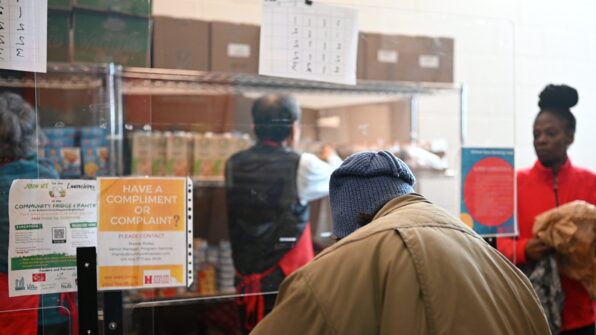
1 in 10 Torontonians turning to a food bank is a daunting number, and it can make someone feel powerless about the situation. By taking this step, you’re empowering yourself and others to take action and directly help people in your own community.
5. You can inspire others to take action
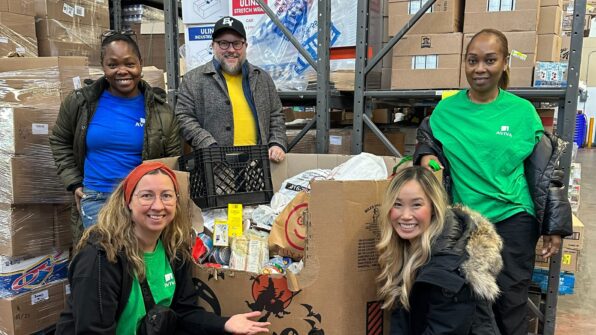
One food drive can spark more, especially when shared on social media or in your workplace. Be the reason someone you know says, “I can help, too.”
6. Kids and teens can lead them too
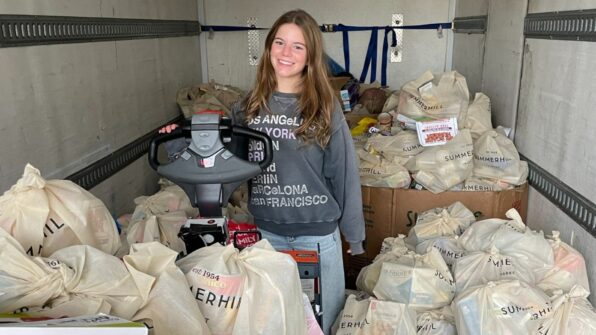
Food drives teach youth about leadership, community values, and the power every person has to make a difference.
For inspiration, check out this family food drive that has been supporting North York Harvest for 10 years!
7. It’s easy to organize, and we’re here to help!
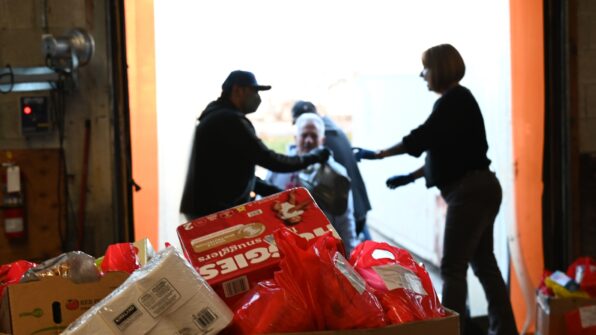
Virtual food drive or in-person – raise food or funds it’s up to you!
Our team will be with you every step of the way to coordinate your successful fundraiser.
8. Reduce food waste
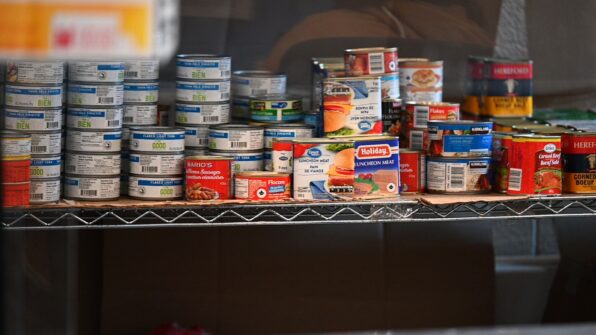
Unused but safe pantry items in your home or office can go directly to someone in need – instead of the trash.
Get started today! To register your food or fund drive and to learn more about our most-needed items, visit here.
Please don’t hesitate to reach out if you have any questions, please contact husnia@northyorkharvest.com.
-
St. Philip Neri’s Table: 4 years of community care
Comments Off on St. Philip Neri’s Table: 4 years of community careAgency Spotlight: St. Philip Neri’s Table

In honour of Mother’s Day this month, we’re sharing how a mother and son’s volunteer work strengthens their bond at St. Philip Neri’s table, a partner agency of North York Harvest Food Bank.
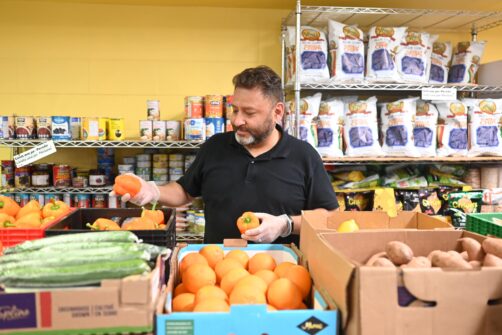
Every Saturday Yesmil and a dedicated team of 50 volunteers distribute essential food and other support to their community. Yesmil co-founded the food bank with the then-pastor of St. Philip Neri Catholic Church in 2021, after seeing the need in their community surge during the pandemic.
It has since become a lifeline for many in the community.
“My family’s support makes all the difference,” Yesmil says. “The volunteers, including my sons, who have accompanied me from the beginning, help make real connections with our clients. Together, we’ve created a welcoming space for all.”
The team’s combined efforts provide emergency food to 230 households each week, serving a diverse community in the Jane and Wilson area, including many new moms, seniors, and others struggling to make ends meet.
“It’s not just about food,” Yesmil adds. “We
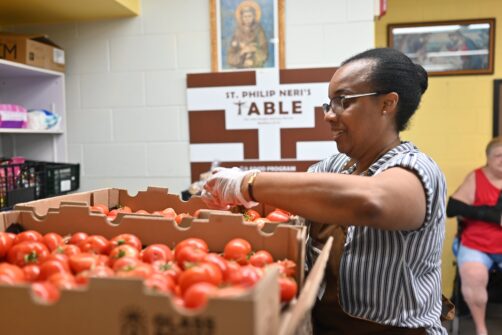
also focus on essential items like diapers, adult diapers, and baby formula—things that often take up a large portion of someone’s income.”
One client, who is also a volunteer, shared that “If it weren’t for the baby formula I receive here, I wouldn’t have been able to raise my grandchild.”
On Saturday, May 17, St. Philip Neri’s commemorated their four-year anniversary by serving their community soup and bread before distributing food.
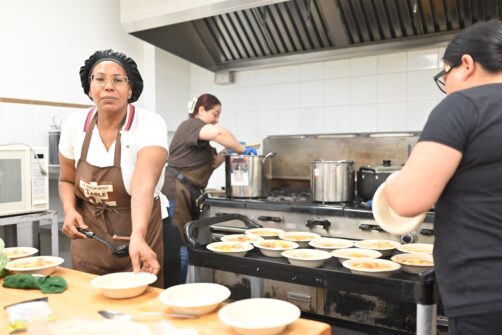
“This mission would not be possible without the collective effort of the volunteers and the entire community,” Yesmil says, “ and working as a family for the community brings immeasurable value.”
-
How your support changed a mother’s life
Comments Off on How your support changed a mother’s lifeYour support changed a mother’s life
Josephine was 20, pregnant, and terrified the first time she came to North York Harvest Food Bank.
She was living in a shelter after fleeing an abusive relationship, unsure how she would provide food and shelter for her baby.
Josephine was navigating motherhood by herself, but thanks to your support – she wasn’t alone.
At North York Harvest, not only did she receive nutritious food to keep her and her baby healthy, she found support with resources like housing, furniture, clothing, and prenatal care.
When she no longer had to focus all her energy on surviving, Josephine was empowered to return to school and start her own construction business.
Hear from Josephine how the care of her community helped her get back on her feet and provide food security to her family.
A donation of any amount provides critical support to community members just like Josephine. You can change a life today by making a special gift
